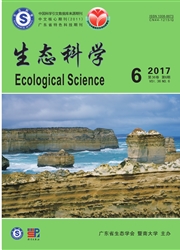

 中文摘要:
中文摘要:
利用密闭箱一气相色谱法于2006-2007年对黔中喀斯特地区土壤二氧化碳、氧化亚氮和甲烷的释放通量进行原位观测,研究我国南方喀斯特石漠化地区土壤温室气体地气交换特征。结果表明:喀斯特石漠化地区土壤是大气C02、N20的释放源,CH4的吸收汇。土壤CO2的释放通量介于450.8±50.8—1281.3±214.7mg·m^2·h^-1在之间,夏秋季节高于冬春季节;N2O的释放通量介于.25.4±4.1~105.8±31.2μg·m^-2·h^-1之间,在夏季最高,在9月、11月和12月出现土壤对大气N2O的吸收;全年CH4交换通量介于.0.27±0.18-0.81±0.26mg·m^-2·h^-1之间,随季节的变化不明显。气候条件对土壤CO2和CH4交换通量的影响较小,土壤水分对N2O释放通量的影响效应在不同的季节不同。相关分析结果显示,土壤N2O和CH4地气交换通量受到土壤硝态氮含量的调控。
 英文摘要:
英文摘要:
CO2, N2O and CH4 fluxes from Karst rocky desertification areas in central Guizhou were measured monthly by using static chamber-GC method from June 2006 to May 2007 to investigate the characteristics of seasonal change of greenhouse gas fluxes from soil in Karst region in South China. The results indicate that the soils are the sources of CO2 and N20, but the sink of CH4. CO2 fluxes change from 450.8±50.8 to 1281.3±214.7 mg·m^-2·h^-1, with higher fluxes in summer and autumn, but lower fluxes in spring and winter. N2o fluxes vary from -25.4±4.1 to 105.8±31.2 μg ·m^-2·h^-1, with the highest fluxes in summer. The soils absorb N2O in the air in September, November and December. CH4 fluxes show no significant changes with the seasons, and they vary from -0.27±0.18 to 0.81±0.26 mg·m^-2·h^-1. The climate conditions have no obvious effects on the fluxes of CO2 and CH4.The effects of soil water on N2O fluxes vary with seasons. The correlation analysis shows that there is significant correlation between soil nitrate content and N2O/CH4 fluxes, suggesting nitrate content in soil is the primary driven factor affecting the seasonal change of N2O and CH4 fluxes.
 同期刊论文项目
同期刊论文项目
 同项目期刊论文
同项目期刊论文
 Coupled effects of irradiance and iron on the growth of a harmful algal bloom-causing microalga Scri
Coupled effects of irradiance and iron on the growth of a harmful algal bloom-causing microalga Scri Effects of temperature, salinity and irradiance on the growth of the harmful dinoflagellate Prorocen
Effects of temperature, salinity and irradiance on the growth of the harmful dinoflagellate Prorocen Effects of organic carbon sources on growth, photosynthesis, and respiration of Phaeodactylum tricor
Effects of organic carbon sources on growth, photosynthesis, and respiration of Phaeodactylum tricor Darkness and UV radiation provoked compensatory growth in marine phytoplankton Phaeodactylum tricorn
Darkness and UV radiation provoked compensatory growth in marine phytoplankton Phaeodactylum tricorn 期刊信息
期刊信息
